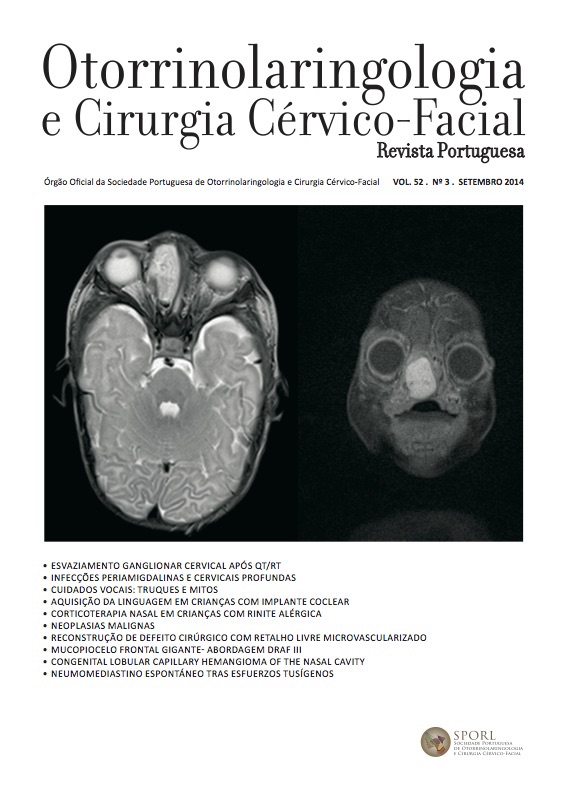Neck dissection after chemoradiotherapy at the IPO FGL
DOI:
https://doi.org/10.34631/sporl.446Keywords:
Neck dissectiom, Oncology, Head and Neck CancerAbstract
Introduction: Radiotherapy and chemotherapy are treatment strategies for head and neck oncologic patients. In many cases they are the first line treatment, especially in locally advanced disease. Neck dissection would be done if the disease persisted after chemoradiotherapy.
Controversy lies on the N2/N3 cases with total response due to difficult clinical, imagiological and histological evaluation. The sistematic pos chemoradiotherapy neck dissection defensors talk about a better regional disease control, and say that a clinical response doesn´t mean a remission. On the other side, the nech dissection on patients with residual disease defensors claim that after a complete clinical response the probability of a single regional recorrence is very small; for that, the systematic neck dissection would be an unnecessary cause of morbility.
In IPO FGL neck dissection after chemoradiotherapy is performed if clinical or imagiological signs of persistente of disease are noticed.
The imagiological evidence is evaluated with a cervical CT and/ or ecography 6 weeks after the chemoradiotherapy treatment; nowadays a PET scan is usually performed.
Objective: to caracterize the head and neck oncologic patients with persistent disease after chemoradiotherapy leading to neck dissection for regional disease control.
Material and methods: revision of 71 clinical records of patients who underwent neck dissection in 2001-2010; the patients who had local disease surgery, as inicial therapy or salvage therapy, were excluded. Twenty three patients who had chemoradiotherapy as first line treatment, and a posterior neck dissection because of persistent local disease, were selected.
Results: From the selected group, 7 had a primary nasophraynx neoplasm, 7 a primary amígdala neoplasm, 7 a hypopharynx/ tongue base neoplasm and 1 a primary palatal tumor. The neck disease was N2/N3 in 74% of the cases. All of them had a cervical CT scan after chemoradiotherapy, 2 of them also had a PET scan. The histological exam of the ganglia dissected was positive for neoplasic cell in 83% of the patients.
Conclusion: Neck dissection is importante in regional disease control and in the survival rates in head and neck cancer patients who have chemoradiotherapy as first line treatment. The results are satisfactory regarding the follow up eficacy, resulting in surgery in patients with persistent disease anf avoiding morbility in patients who wouldn´t have any benefict with surgical therapy.
Downloads
References
Ferlito A, Corry J, Silver CE, Shaha AR, et al. Planned neck disseccion for patients with complete response to chemoradiotherapy: a concept approaching obsolescence. Head Neck 2010; 32: 253-61
WHO. Handbook for reporting results of cancer treatment. Geneva, Suiça: World Health Organisation; 1979. P 48
Therasse P, Arbuck SG, Eisenhauer EA, et al. New guidelines to evaluate the response to treatment in solid tumors. European Organization for Research and Treatment of Cancer, National Cancer Institute of the United States, National Cancer Institute of Canada. J Natl Cancer Inst 2000; 92: 205-216
Miriam N, Lango MD, Jeffrey N, Myers MD, et al. Controversies in Surgical Management of the Node-Positive Neck after Chemoradiation. Seminars in Radiation Oncology, 2009 Jan 19(1): 24-28
Thariat J, Hamoir M, Janot F, De Mones E, et al. Place du curage ganglionnaire après chimioradiotherapie dans les carcinomes epidermoides des voies aerodigestives superieures avec atteinte ganglionnaire initiale (nasopharynx exclu). Cancer Radiothérapie 13 (2009) 758-770
The Departments of Veterans Affairs Laryngeal Cancer Study Group. Induction chemotherapy plus radiation compared with surgery plus radiation in patients with advanced laryngeal cancer. N Engl J Med 1991; 324: 1685-90
Mendenhall WM, Villaret DB, Amdur RJ, Hinerman RW, et al. Planned neck dissection after definitive radiotherapy for squamous cell carcinoma of the head and neck. Head Neck 2002; 24: 1012-1018
Velazquez RA, McGuff Hs, Sycamore D, Miller FR. The role of computed tomographic scans in the management of the N-positive neck in head and neck squamous cell carcinoma after chemotherapy. Arch Otolaryngol Head Neck Surg 2004; 30: 70-74
Roy S, Tibesar RJ, Daly K, et al.Role of planned neck dissection for advanced metastatic disease in tongue base or tonsil squamous cell carcinoma treated with radiotherapy. Head Neck 2002; 24: 474-481
Van der Putten L, Van der Broek GB, de Bree, et al. Effectiveness of salvage selective and modified radical neck dissection for regional pathologic lymphadenopaty after chemoradiation. Head Neck 2009; 31: 593-603
Porceddu SV, Jarmolowski E, Hicks RJ, et al. Utility of positron emission tomography for the detection of disease in residual neck nodes after chemoradiotherapy in head and neck cancer. Head Neck 2005; 27: 175-181
Stenson KM, Haraf DJ, Pelzer H , et al. The role of cervical lymphadenectomy after aggressive concomitant chemoradiotherapy: the feasibility of selective neck dissection. Arch Otolaryngol Head Neck Surg 2000; 126:950-956
Goguen LA, Chapuy CI, Li Y, Zhao SD, et al. Neck dissection after chemoradiotherapy: timing and complications. Arch Otolaryngol Head Neck Surg 2010; 36: 1071-1077
Ganly I, Bocker J, Carlson DL, et al. Viable tumor in postchemoradiation neck dissection specimens as an indicator of poor outcome. Head Neck 2011; 33: 1387-1393
Sher DJ, Tishler RB, Annino D, Punglia RS. Coast-effectiveness of CT and PET/CT for determining the need of adjuvant neck dissection in locally advanced head and neck cancer. Ann Oncol 2009; 21:1072-1077
Hillel AT, Fakhry C, Pai SI, et al. Selective versus comprehensive neck dissection after chemoradiation for advanced oropharyngeal squamous cell carcinoma. Otolaryngol Head Neck Surg 2009; 141: 737-742






